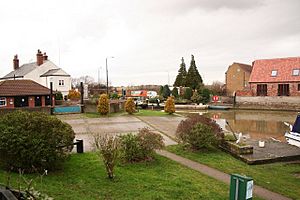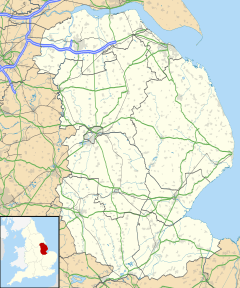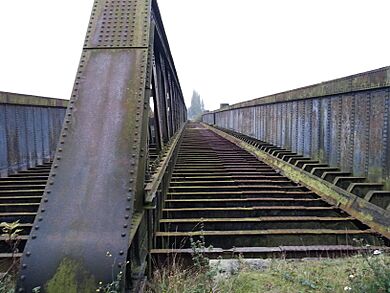Torksey facts for kids
Quick facts for kids Torksey |
|
|---|---|
 Torksey Lock slipway |
|
| Population | 875 (2011 census) |
| OS grid reference | SK837786 |
| • London | 130 mi (210 km) S |
| District |
|
| Shire county | |
| Region | |
| Country | England |
| Sovereign state | United Kingdom |
| Post town | LINCOLN |
| Postcode district | LN1 |
| Police | Lincolnshire |
| Fire | Lincolnshire |
| Ambulance | East Midlands |
| EU Parliament | East Midlands |
| UK Parliament |
|
Torksey is a small village in Lincolnshire, England. It is located in the West Lindsey area. In 2011, about 875 people lived here.
The village is on the A156 road. It is about 7 miles (11 km) south of Gainsborough. It is also about 9 miles (14 km) north-west of Lincoln. Torksey sits on the eastern bank of the River Trent. This river forms the border with Nottinghamshire.
Torksey is famous for its history. It has a Roman canal and was once a big Viking camp. You can also find the old Torksey Castle and the Torksey Viaduct here.
A Look at Torksey's Past
Torksey has a long and interesting history. People have lived and built things here for a very long time.
The Ancient Roman Canal
The Foss Dyke is a very old canal. The Romans built it around the 2nd century. A canal is like a man-made river. It helps boats travel between different waterways. The Foss Dyke connects to the River Trent. It uses special gates called lock-gates. These gates help boats move up or down between different water levels. The canal joins the river about half a mile (800 meters) south of Torksey village.
The Vikings' Winter Camp
In the 800s, Torksey was part of an Anglo-Saxon kingdom called Lindsey. Around 860 AD, a large group of Viking warriors came to England. The English called them the "Great Heathen Army". They took over parts of eastern England.
In 871–872, the Vikings stayed in London for the winter. But they soon went back to Northumbria. In 872–873, the Great Heathen Army set up their winter camp in Torksey. This camp was between Torksey and Marton, east of the River Trent.
Scientists have studied the area. They found that the Viking camp was very large. It covered about 55 hectares (136 acres). Many Viking-Age metal objects have been found there. These finds help us learn about how the Vikings lived.
Torksey Castle's Story
Torksey Castle was built in the 1500s. It was a large, fancy house. Today, it is a ruin. This means it is mostly broken down. The castle was destroyed in August 1645. This happened during the English Civil War. Its remains are near the river, behind a protective wall called a dike.
Torksey Viaduct: A Special Bridge
The Torksey Viaduct is an old railway bridge. It is no longer used for trains. This bridge has two long sections, each about 130 feet (40 meters) long. It crosses the River Trent.
Building the Viaduct
The viaduct was built between 1847 and 1849. It was made for the Manchester, Sheffield and Lincolnshire Railway. The bridge has a very special design. It is known as the first "box girder bridge". This means its main support beams are shaped like hollow boxes.
The famous engineer John Fowler designed it. He was inspired by other bridges that used hollow tubes.
A New Purpose for the Bridge
The viaduct stopped being used for trains on November 2, 1959. It was too expensive to fix it. Later, an environmental group called Sustrans decided to give the bridge a new life.
They worked to turn the viaduct into a path. This path is for walking and cycling. In 2015, they got permission to build the paths. The goal was to connect quiet roads on both sides of the river. In April 2016, the Torksey Viaduct opened for walkers and cyclists. Now, people can enjoy crossing the River Trent on this historic bridge.




